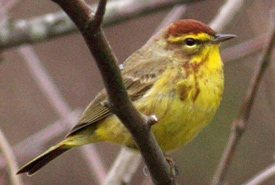Welcome snowbirds!

Palm warbler (Photo by Marshall Faintich)
Hey Canada, hey Virginia…it only seems a short time has passed since I was telling you all that our wintering palm warblers were leaving Florida and heading your way. Thanks to the great conservation efforts taking place to conserve habitat throughout North America, these delightful little birds have had a successful nesting season and migration along the Atlantic Flyway.
For many of them, Florida is the last port of call. They will spend the winter in our hardwood hammocks, forests and prairies. After a period of rest, some will continue their journey beyond our shores to the Caribbean Islands and the tropical forests of South America.
Snowbird paradise
Here in Florida, palm warblers will form loose flocks with resident pine warblers, eastern bluebirds and other snowbirds from the north, such as yellow-rumped warblers and savannah sparrows. They take advantage of a variety of habitats, from open prairie to coastal strand and hardwood hammocks to pine flatwoods. Without well-managed wild lands, they would have nowhere else to go.
Florida has more than 9 million acres (3.6 million hectares) of public conservation lands that provide a winter home for more than 200 species of birds, many of which migrate to and from Canada along the Atlantic Flyway.
Endless opportunity
There is an endless supply of opportunities for bird enthusiasts in Florida. The Florida Fish and Wildlife Conservation Commission (FWC) provides access to more than 5.8 million acres (2.3 million hectares) established as wildlife management areas or wildlife and environmental areas. The FWC also manages the Great Florida Birding & Wildlife Trail, a network of 510 individual sites spread across the state.
Many of our migratory birds, including the palm warbler, rely on these conservation lands for their survival and well-being. Take advantage of the opportunities provided to enjoy these little birds during fall migration, and in the months that follow. Remember, if you miss out this fall there is always next spring when the birds return.
Strong partnerships
Ensuring that these migratory birds have adequate resources to keep them healthy over the winter is critical for their survival, so they can return to their nesting grounds and raise future generations. By forming strong partnerships within Florida and beyond, the FWC can fulfill its mission to manage fish and wildlife resources for their long-term well-being and the benefit of people.
We are grateful to our partners in Canada, Virginia and beyond for their conservation efforts while our birds are in their capable hands. Conservation across the entire Atlantic Flyway and beyond is vital to helping ensure the survival of our migratory birds; birds don’t do borders!
This blog is reposted with permission from One Sky Our Bird's blog.

